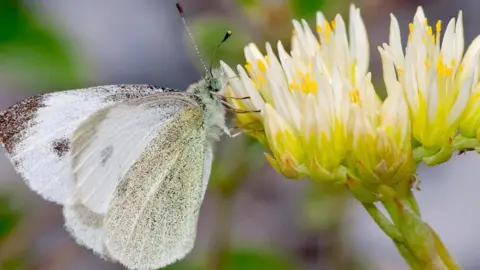Recently, a remarkable event has been recorded in the UK pertaining to the world of butterflies; a species previously confined to Southern Europe has made its debut on British soil. This exciting discovery was reported by Butterfly Conservation, an organization dedicated to the protection and conservation of butterflies and moths. The Southern Small White butterfly, which had until now remained primarily in regions such as Southeast Europe, has been viewed in the UK for the first time.
The Southern Small White butterfly is known for its distinct appearance. It features a white body with two notable black spots adorning its wings. Experts and enthusiasts alike have closely monitored the butterfly’s gradual northward migration across Europe over the past few decades, leading to this significant sighting in the UK. The first confirmed appearance took place at the Landguard Bird Observatory located in Suffolk, England, when a volunteer named Will Brame took a photograph of the butterfly on August 2, 2025. This sighting marks a pivotal moment in the butterfly conservation community as it suggests a shifting habitat and behavior regarding this particular species.
The driving forces behind this geographic expansion are still being investigated. While numerous factors could contribute, climate change is considered a significant element influencing the Southern Small White’s northerly trek. Although such butterflies had previously been predominantly sighted south of the Alps—first appearing in France and Germany in 2008—rapid changes in climate have likely made it more feasible for the species to inhabit areas that were once deemed unsuitable.
Butterfly Conservation’s extensive research indicates that the Southern Small White butterfly had gradually extended its range since first breaching its historical boundary. Notable expansions include the species reaching the Netherlands in 2015 and even Calais in 2019. In the incident at Landguard Nature Reserve, Brame’s keen observational skills allowed him to capture evidence of this butterfly, reinforcing the worthwhile efforts of butterfly watchers and citizen scientists.
Identification of the butterfly was professionally confirmed by Chris van Swaay, an expert from Dutch Butterfly Conservation. His expertise solidified the credibility of this identification and highlighted the increasing importance of citizen involvement in biodiversity monitoring. The discovery not only fuels excitement within the ecological community but also raises questions about future implications for the ecosystem and invasive species management.
Dr. Dan Hoare, Director of Nature Recovery at Butterfly Conservation, remarked that the Southern Small White has made an “ecological leap” into new territories. While the occasional migration of rare species has been noted within the UK, this development presents a more pronounced shift in the butterfly population’s dynamics. Dr. Hoare elaborates that the species has colonized various regions stretching from the Swiss Alps to the North Sea, moving at an astonishing rate of roughly 100 kilometers annually.
However, questions linger regarding the sustainability of the Southern Small White’s presence in the UK. The butterfly primarily feeds on a plant known as Candytuft, which is not commonly found in British gardens. As the species is not historically a migrant to the UK and lacks evidence of breeding within its new habitat, its long-term viability remains uncertain.
In summary, the Southern Small White butterfly’s sighting is not mere coincidence but highlights the pressing realities of climate change affecting species distribution. As the ecological landscape metamorphoses, it becomes imperative to observe, document, and protect these changes to ensure the sustainability of both the species and their habitats. The future may hold further surprises as other non-native species potentially follow in the footsteps of the Southern Small White, leading to significant shifts in UK biodiversity.











